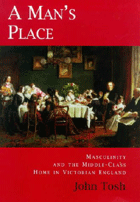Author's response
| Book: | A Man's Place: Masculinity and the Middle-Class Home in Victorian EnglandJohn ToshYale University Press 1999 |
| Reviewer: | Professor Anthony FletcherUniversity of Essex |
In his generous and thoughtful review of my book, Anthony Fletcher raises again the central question posed by the recent practice of the history of the family: can we reconstruct anything more than the ideology of familial relations? In the case of the Victorian middle class, there was so much self-consciousness about family life, and so much prescriptive literature intended to mould it along predetermined lines, that there is clearly a danger that the historian will become the prisoner of ideology. In fact I spent much more time researching family papers than advice texts. My purpose was not to assemble the materials for a comprehensive social analysis, since qualitative research reflecting every nuance of religion, occupation and region would be the work of a lifetime. But neither do my case studies merely serve to illustrate the precepts of such luminaries as Sarah Ellis and William Landels (incidentally the names of these and other best-selling advice-writers of the day hardly ever crop up in family correspondence). What they document is how particular patterns of family life were formed, how they were lived and understood, and how they reflected social circumstance and cultural convention. Domesticity is, as Fletcher points out, an ideological product, but it is not only that, and the bourgeois lives which recur through my pages show what it meant in both economic and emotional terms.
The use I make of case-study material has a bearing on another central issue. My book is committed to the proposition that a gendered history of men must be relational, in the sense of being rooted in an understanding of masculinity and femininity as aspects of a gender order, each incomprehensible without the other. Fletcher does not dwell on this point, being more concerned to comment on my arguments relating to fatherhood and manliness. But the relational perspective is central to the history of the family. The difficulty is that this perspective, so incontrovertible in theory, readily lends itself to over-schematic generalisations about separate spheres or companionate marriage. More is revealed about masculine identity, I would argue, in the story of Edward Bensons marriage to a child-bride, or Isaac Holdens battle with his strong-minded second wife, than in all the homilies addressed to young men on the threshold of adulthood.
I suspect that the ideal of comprehensive coverage against which Fletcher measures my work (and that of others) is a will-o-the-wisp. Caught between the generalising tradition of social history and the pointilliste techniques of the cultural historian, historians of the family need to take careful stock of their methodology. Before we dispatch droves of research students in a concerted campaign of reclamation, it would be as well to clarify the gains in insight and explanation to be had from more focused and more practicable enquiries.
October 1999

